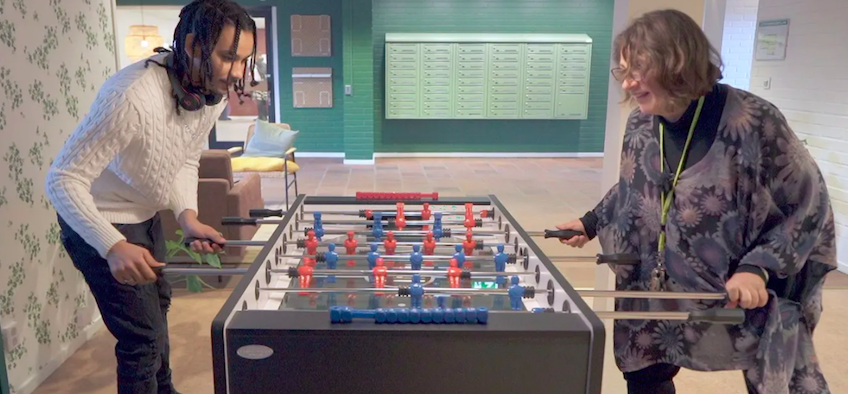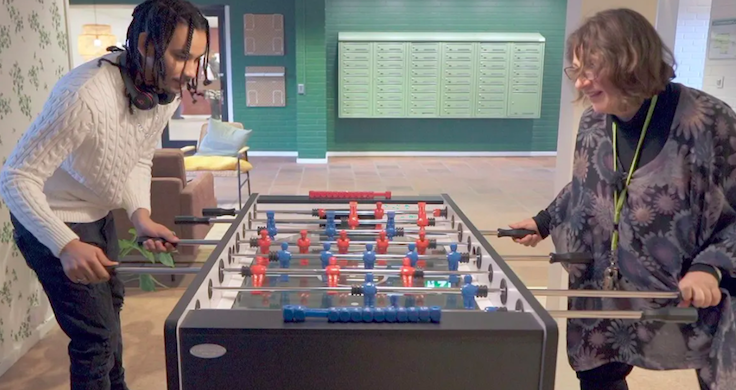“A new way to live” states the website of the revolutionary SällBo co-housing project where young people between the ages of 18 and 25, including refugees, and over 70s live together. The aim of mixing these different groups is to support social interactions of people who can easily feel like outsiders, isolated and lonely. The different generations and cultures learn from and support each other under one roof where communal decision-making is part of the rental contract. SällBo offers a lot of communal space: each floor has communal kitchens, a living room, a library, a carpentry room, art room, yoga room and a garden. The municipal housing company that owns the building took a risk with this new model but its success has resulted in other Swedish and European municipalities visiting for study missions, with the aim to replicate the model.
Helsingborgshem is a municipal-owned housing company and the largest supplier of public housing in the city of Helsingborg in Southern Sweden, offering public housing to a diverse population in a city of 132,000 inhabitants. In this article, we take a closer look at Helsingborgshem’s project SällBo with Dragana Curovic, an Integration specialist and project manager at SällBo.
How did the idea for this intergenerational, intercultural co-living space arise?
The building was originally a home for the elderly, owned by the municipality. When they decided to sell it, we, as a municipality-owned company, thought it would be a great idea to buy it because we had a lot of elderly people in the area and in Helsingborg who were already waiting in line to be accommodated into safety housing. “Safety housing” or “safety living” is a form of habitation common in Sweden for people above the age of 70 where they have their own apartment, yet in the same building there are community rooms for socialising with the support of an activity host.

We started the renovation of the building in 2015, at the time when the refugee crisis hit Europe and Sweden, which ended up changing the direction of our idea. For ten years already we had had an agreement with the government to provide housing for unaccompanied refugee children in Helsingborg. This used to be about 30 persons a year, but in October 2015, there were 459 unaccompanied refugees waiting to be accommodated. In response to the refugee crisis, the municipality decided to rent the bottom floor of this building to some of the youngsters who were in Helsingborg at the time. In the end, 98 youngsters moved in and lived there for almost three years.
We were also having dialogues with tenants in surrounding areas, which showed us that elderly people were feeling lonely in their everyday lives. Many lived alone, they felt excluded from society, sensing that they could not keep up with the enormous amount of information coming from all directions. At this time, we saw the need to combine these groups: the elderly and the young refugees who do not otherwise get much contact with others living in Sweden. We also realised that not only the unaccompanied refugee children, but also some youngsters with well-established family backgrounds and support systems had similar sense of loneliness.
Can you tell us about the residents in SällBo? What are the requirements to secure a place in this co-housing?
The tenants are either between 18 and 25 years old, or above 70 years old. Age is a main factor in the concept of SällBo, which aims to bring people together from different generations to interact with each other. In order to fulfil SällBo’s aims of a collaborative environment, tenants are expected to socialise with other residents through different activities at least two hours a week. In order to be suitable to live in SällBo, those seeking housing must have a resident permit for living in Sweden, speak basic Swedish or English, and have an income amounting to at least two month’s worth of rent.
There are 51 apartments at SällBo. 60% of the apartments at SällBo are for elderly people, 40% of the apartments are equally shared between the different youth groups. Half of them are former unaccompanied young refugee men or boys, the other half of young people under the age of 25. By signing a contract renters agree to attend the monthly house meetings and assemblies where the tenants discuss and decide on issues such as about the community areas.

What is the process of selecting and approving new tenants? What kind of contracts do they have?
We make sure that each tenant is different from the other. We currently have 58 people living in the house who are really different from each other, having diversity in values, in personalities, in social status, in education, in interests, and so on.
The elderly people receive permanent contracts to feel safe moving here, because a lot of them expressed fears that it might be the last place they live in, and they would not want to move again. Because of the strong feelings of the elderly, we decided that in case the project does not work, we would make it exclusively into a for elders. Initially, there were much more elderly people who applied. As the word spread in the media and through people, we started to get many interested youngsters. During the testing phase of SällBo youngsters had only temporary contracts but SällBo became more established, now they also get permanent contracts and can stay as long as they wish, without an age limit. But when a vacancy opens up in their apartments, we only admit people who are between 18 and 25 years old.
What kind of life situations are the residents experience when applying to live at SällBo?
We conducted a workshop with all the target groups. In the elderly group we have a mix of people: those who are in the queue for safety housing, but also people who do not want to live in a safety house, or have never thought of living in a shared space. Some from the young refugee group are people who were living in temporary apartments waiting to get their own apartment. Some were students, while others were working. The response about living together was positive from all target groups, which made us believe that what we are doing is needed and useful.

How does SällBo compare to other offers on the housing market supplied either by Helsingborgshem or the private rental market?
In Sweden we do not have social housing as such. We have municipal-owned housing which has the duty to find housing for every type of tenant in society, meaning that we have both expensive and cheap apartments. It is our job to match housing with the needs of the local inhabitants.
I believe that SällBo could also work in the private housing market. The rents at SällBo are not the lowest in the municipality, but they are in the lower range. It is not impossible even for the private sector to launch such a project, if the building is already there.
How is mutual interaction and socialisation encouraged and facilitated?
We encourage tenants to organise activities themselves, we do not do this for them. Socialisation means being open with your neighbours. This can mean just sitting beside a neighbour in the community area, maybe reading your book while others are playing Sudoku. We have a host. Her main work is not to organise activities but to provide support and facilitate inclusivity: in a house like this there can be a tendency to form groups. One of the biggest jobs of the host is to make sure everyone is included and there are no groups that feel exclusive to others.

The communal areas are meant for those who live in the building, it is not open to the public. We asked the people what kinds of areas they need in order to feel comfortable in socializing. The tenants understood that they cannot have everything, because then the rent would have to be higher. This mentality helped to keep the requests for shared space reasonable. The only requirement on our side was that all the rooms would be available for use for all three target groups.
While we cannot provide more economic resources to change furniture in community rooms than what we had already invested, we let tenants develop activities themselves and this leads to promising results: a carpentry room has just been created, for example. The only thing that we helped with was emptying a room and providing some of our old furniture. But all the tools, everything that was needed for the carpentry room was sourced by the residents.
What are the typical activities the young and the elderly share?
They cook together, play puzzle, play video games, watch films, paint, or do arts and crafts. They often tend to the garden together, while others like to just talk to each others and share stories. There are many ways the elderly residents can support the youngsters: for example, as some elderly have cars, they let the youngsters practice driving in their own cars and prepare the them getting driver licenses. Sometimes they drive them t doctors appointments, or help them with shopping.

What does an average week living in SällBo look like?<
During the day there are mostly elderly people in the house because the youngsters are either working or going to school. This means that there are a lot of activities among the elderly: they go shopping together, read, and go for walks. Even those who are the oldest in the house are out and about daily with the other residents. From around 4pm to 6pm, the youngsters start arriving home and stat mixing with the elderly. They meet, talk and have some activities together. We mix up people living next to each other to encourage people to get to know each other and talk to each other, even if they do not have similar daily schedules. Then during the weekends, there are opportunities to spend time together, such as doing barbecues or celebrating holidays.
Interview by Ulrika Stevens, edited by Sophie Bod.


